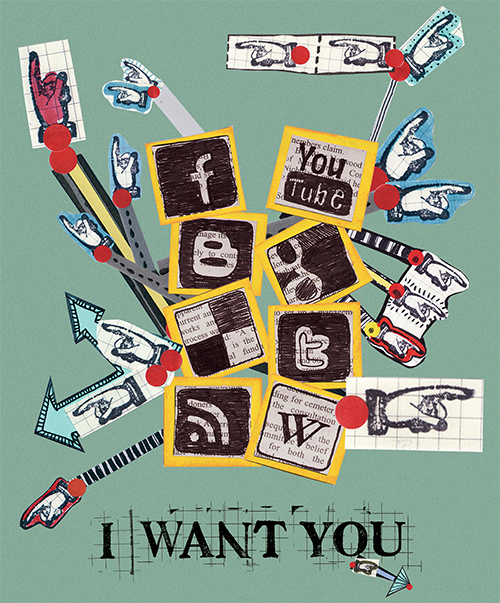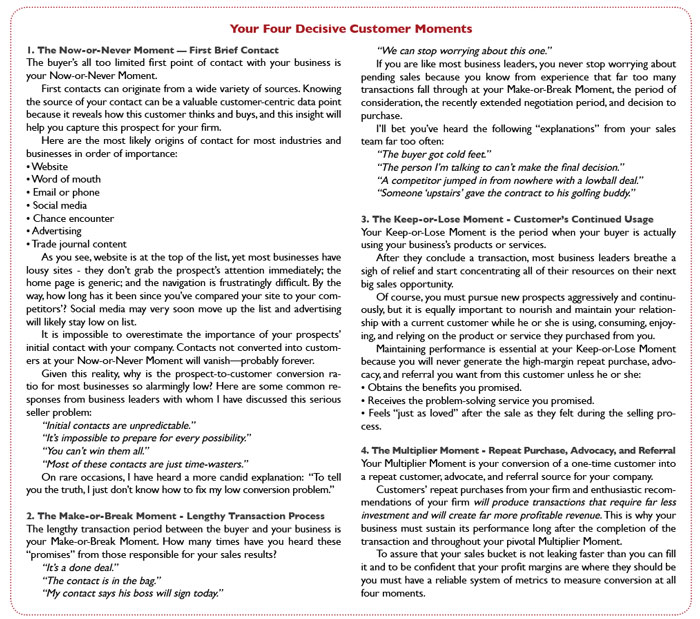Today, sellers live in a virtual glass houses – they are stripped naked by social media, vulnerable to the attitudes, positive and negative, of the “new experts.”
In 2010, customers discovered that loyalty is no longer in their best interest. Why did this profound transformation occur at this moment in time?
The answer is a single word: change.
The velocity of today’s change is almost unfathomable.
The changes in our world are no longer easy to predict.
All businesses are or will be affected, most quite severely, by these rapid and seemingly unpredictable changes.
Here are a few vivid examples of this irreversible change:
Books for Amazon’s e-reader outnumber sales for hardcover books: “The shift is astonishing when you consider that we’ve been selling hardcover books for 15 years and Kindle books for 33 months,” said Amazon.com CEO, Jeff Bezos. (IHT, July 21, 2010 and July 30, 2010)
Procter & Gamble decides to sell directly to consumers on the internet: “I don’t feel the need to have every sale go through a retailer,” commented P&G CEO Robert McDonald. McDonald and former CEO AG Lafley agree that P&G must always be where the consumer wants to shop. (FT, May 20, 2010)
In less than four months last year, Apple sold more than 3 million iPads, generating revenue of $2.1 billion: “iPad is off to a terrific start. We have some amazing new products coming out this year,” said Steve Jobs, Apple CEO, regarding the firm’s net income growth of 78% in Q2. (NYT, July 22, 2010)
[ms-protect-content id=”9932″]Italy’s Fiat takes over one of America’s iconic “Big Three” Car Manufacturers: “In 2010, Sergio Marchionne, CEO of Fiat Group, marketer of legendary automotive brands, Alfa Romeo, Lancia, Ferrari, Maserati, and Fiat, announced “the creation of a global automotive firm that will incorporate Chrysler.” This development is even more astonishing when one understands that Fiat reported a net loss of €2 billion in 2002. Just three years later, Marchionne reported all-time high trading profits by restyling all of Fiat’s models and launching the brilliantly cool Cinquecento (500), the brand that encourages buyers to co-design on the internet. The 500, “European Car of the Year”, will soon be introduced in the U.S. (IHT, July 22, 2010)
Could any of us have predicted the preceding changes in our business world five years ago? Or, even last year?
A few business leaders seem to have been born with the ability to look “around the corner” and still others are able to cultivate this valuable talent. Unprecedented change is now affecting your business and businesses of every size, type, and location. It is vital to acknowledge that:
Change will not stop doing what it does best – change. Technology’s influence on everything will not change. Globalization’s influence on every enterprise will not change. The pace of change will intensify because every developed nation will strive to outperform every other nation in this highly competitive arena.
This unrelenting change will probably take a breather from time-to-time, as it has in the past, due to external influences such as the economy, wars, humankind’s knack for fouling things up, and the reality that rhythm seems to be an integral part of everything on this planet. At some point, when the world settles down once again, change will shift back into high gear and usher in a new phase of accelerated change.
The scale and pace of change have also caused a radical and permanent change in customer purchasing behavior.
Your customers – the “new experts” – are now armed with lethal weapons unavailable to previous generations:
Instant, comprehensive information from the internet about all products and services sold – online and offline Immense choice in every segment of commerce – a wide variety of options, features, and prices in every local community and from every corner of the world
Real-time price comparison at the moment and location of purchase on smarter-and-smarter smart phones and newer-and-newer apps on customers’ ubiquitous mobile devices
Social media constantly informs and influences these intensely self-centered “new experts.” Facebook, Yelp, and Twitter enable these “new experts” to share and compare their real and perceived purchase experiences – online and offline – with millions of people around the globe. Today, sellers live in a virtual glass house – they are stripped naked by social media, vulnerable to the attitudes, positive and negative, of the “new experts.”
As a result, customers – every age, gender, and culture – have become indifferent to where or from whom they purchase as evidenced by these facts:
In 2009, only 36 percent of business travelers claimed that they were brand loyal, compared to 42 percent in 2007. (NYT, December 1, 2009).
In 2009, only 20 percent of US car buyers were brand loyal, compared to 80 percent in the 1980s. (NYT, October 20, 2009).
Most of today’s shoppers are addicted to sites that instantly compare choice, availability, quality, service, and the most dangerous comparison of all – price.
There is no longer any difference in the purchase behavior of “online customers” and “offline customers” because everyone thinks and acts like a “new expert.”
Writing in Forbes.com/CMO Calculus, in a piece called “Is Customer Loyalty Dead?” marketing guru Mike Linton advises companies to acknowledge that there is this “new world order” among buyers. His example proves his point: “An auto salesperson recently explained that he had lost a sale, after three meetings and numerous calls, because the customer used the Internet to find the same car for $100 less ten miles away.” (August 28, 2009) Unlike Frankenstein, customer loyalty will not rise from the grave that was dug by the robust economy of the previous decade, abundant choice, and seller apathy. Search engines presided over customer loyalty’s funeral and empowered buyers to take control of their entire buying experience.
You and other ambitious business leaders must realize that:
This generation of empowered and aggressive buyers is armed with lethal high-tech weapons that induce profit-draining customer churn in all-too-many businesses today.
Future generations of customers will have access to even more powerful technology and be even more determined to use it for their selfish benefit, not yours.
Competitors in your category who adapt to this new reality quickly will have the capacity to convince these “new experts” to buy from them, not you.
However, you can convert prospects into customers and customers into enduring customers who advocate for and refer business to your brand or business by thinking like your buyer.
Buyers — every human being on this planet, including you and me — have wants, needs, and aspirations as well as apprehensions, concerns, and fears. These emotional forces —whether positive or negative — drive our purchase decisions.
The couple wants a sleek new BMW convertible to give them pleasure, feed their egos, get them to their destination in style, and reward them for their hard work.
Our company needs a larger crane so that we can win bigger projects, enhance our firm’s reputation, and accelerate our growth.
We have aspirations for our family. Our daughter has the talent to be a gifted pianist so we want to send her to the best music schools and buy her the finest piano.
The couple has apprehensions about walking into a jewelry store to buy a diamond ring because, despite their extensive learning online, they are still unsure of their ability to evaluate or affirm the quality of the mysterious, expensive, and highly desired objects called diamonds.
A manager voices her concerns about choosing and installing a new technology system in their firm because it may not function properly, may end up costing too much, and may become obsolete overnight.
We wake up in the middle of the night because of our fears that the heavy equipment we are shipping halfway around the world will not arrive on schedule or will be damaged en route.
As buyers, we experience emotional impulses such as these much of the time. At these individual and personal buyer moments, our wants, needs, and aspirations and our apprehensions, concerns, and fears motivate us—often compel us—to purchase goods and services. When this appetite to buy is at its strongest, we are impulsive and vulnerable.
This urge to buy is the moment that we, the buyers, can be most easily influenced by a persuasive seller, convinced that this is the seller to buy from and confident that this is the moment to buy.
Yet, most sellers don’t understand that this momentary opportunity to seize control exists or how to capitalize on it.
Buyers are most responsive to a seller’s influence when powerful emotions force buyers’ decision making—when buyers are in the process of purchasing something important.
That something important can be expensive and vital, like a new fleet of trucks, or inexpensive and seemingly unessential, like a fresh bouquet of flowers on Mother’s Day. Both purchases—the trucks and the flowers—are important to the buyer at that crucial moment when he or she has an intense desire to purchase.
But you must remember that buyers, while vulnerable, are still in control of the lengthy purchase progression. Buyers know that they will find products or services to meet their wants, needs, and aspirations and sellers to provide the customer assistance, delivery, and warrantee that will reduce their apprehensions, concerns, and fears. These emotionally driven purchasing events are the Decisive Customer Moments—the vulnerable and impulsive customer moments when you can most easily induce the buyer to choose your firm over your competitors’.
All businesses have four Decisive Customer Moments—four fleeting opportunities when they can make their firm 1st choice and beat out their competitors.
All businesses have four Decisive Customer Moments—four fleeting opportunities when they can make their firm 1st choice and beat out their competitors. To capitalize on these four decisive moments, sellers must change the way they think and act.
It is vital to understand that these four moments are sequential and co-dependent
If you fail to secure the prospect at the first decisive moment, you will never have another opportunity and the same destructive outcome holds true at each of the other three decisive moments.
To achieve success at every moment in the prolonged purchase progression, you must create Customer Preference at each of the Four Decisive Moments.
The simple truths about Customer Preference
When buyers no longer care where they buy, “Customer Preference” is the only differentiator – the surest way to be your customers’ 1st Choice.
Customer Preference, from the customer’s perspective, is deliberately making a choice – deciding from whom or where to purchase in order to obtain a valued benefit.
Here is how a customer might explain his or her way of selecting a vendor: “My preference is based on how good you are at meeting my wants, needs, and aspirations and reducing my apprehensions, concerns, and fears. I have a lot of choices, and I will decide where to buy after looking at all of my options. Given all of my options and all of the factors in my purchase decision, I prefer you”
“I Prefer You!” These three words will give you a potent advantage over your competitors
Think of Customer Preference in terms of the specific advantages it offers you:
• The buyer will go a little out of his or her way to buy from you. • The buyer will pay just a bit more for your firm’s products or services. • The buyer will buy without always demanding a discount. • The buyer will buy from your firm more frequently. • The buyer will be slightly more tolerant when you foul up.
Individually, these benefits may not make or break your financial performance, but they will likely be the fundamental difference between growing and declining in the slow-growth economy we will experience for some time in the future.
Embracing Customer Preference does not require a wholesale rethink of your business plan nor does it require investment in infrastructure or advertising.
Every business can create Customer Preference with big ideas and small ideas at The Four Decisive Customer Moments when the customer feels just a bit vulnerable and seeks the reassuring concern of seller who understands the customer’s wants, needs, and aspirations or apprehensions, concerns, and fears.
Of course, you have experienced all four of these Decisive Customer Moments—you always knew they were important.
However, the purchase progression you have previously experienced has radically changed: your buyers now have immense choice, unlimited access to information about your products or services, and the technology to compare your offer to your competitors’ offers.
Remember that your buyers no longer care whether they buy from you or from one of your numerous competitors – they are now in control of your entire purchase progression.
Success at one, two, or even three Decisive Customer Moments is no longer the enduring, profitable success you seek.
Failure to sustain your performance at all four Decisive Customer Moments is a recipe for business failure.
Make no mistake—you simply cannot get by with: a friendly smile at your brief Now-or-Never Moment; a warm handshake at your Make-or-Break Moment; a form letter with a satisfaction survey at your Keep-or-Lose Moment; a “come back and see us” mailer at your invaluable Multiplier Moment.
To make your brand or business 1st Choice, you must consistently create Customer Preference at all Four Decisive Moments
About the author
Robert H. Bloom is a widely respected authority on business growth. As U.S. Chairman and CEO of Publicis Worldwide, the centerpiece of the $4.6 billion global marketing services company, he helped craft and implement the growth strategies of some of the world’s largest companies and brands, including BMW, L’Oréal, Nestlé, Southwest Airlines, T-Mobile, and Novartis’ Theraflu and Triaminic. As an entrepreneur, he grew an advertising agency into a successful national business.
Bloom advises firms of every type and size on their growth strategies. He is the author of THE NEW EXPERTS: Win Today’s Newly Empowered Customers At Their 4 Decisive Moments, and THE INSIDE ADVANTAGE: The Strategy That Unlocks the Hidden Growth in Your Business.
For more information or to contact Robert Bloom, please visit www.thenewexperts.com
[/ms-protect-content]









![Deconstructing the Myth of Entrepreneurship iStock-2151090098 [Converted]](https://www.europeanbusinessreview.com/wp-content/uploads/2024/09/iStock-2151090098-Converted-218x150.png)


























